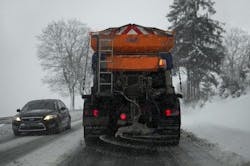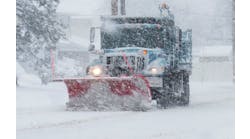Rock salt alternatives are better for infrastructure and the environment
By: Megan Ray Nichols
Each winter, cities across the country spread countless amounts of rock salt—also called road salt—across their roadways to eliminate icy and dangerous conditions. The salt essentially helps the ice melt—eating through the icy layer and getting rid of the slippery surface that can be dangerous to travelers and locals.
Many municipalities and local organizations even provide free salt in areas where frigid conditions are rampant. That means it is incredibly accessible and used openly in various regions.
This is unfortunate because although rock salt is incredibly effective, it has a significant impact on both the environment and our infrastructure. Bridges, roads, buildings, and various other infrastructure components can be damaged by the material. It is dangerous to local wildlife and domestic pets as well.
What damage can road salt cause?
Besides harming local fauna and wildlife when used in great amounts, rock salt is also incredibly damaging to aquatic life and ecosystems. Unnatural materials when used in abundance can create something called dead zones in aquatic ecosystems which essentially suffocates all surrounding life.
Salt is also directly responsible for damaging or eroding certain materials over an extended period. It is now known that the 2012 collapse of the Algo Centre Mall in Elliot Lake, Ontario was the result of rusting from years of water and salt penetration—steel support beams eventually collapsed from the damage.
The rusting and damages caused by rock salts affect many other things too. Vehicles and transportation systems also suffer damage from rusting as a result of karst and road salt. Salty runoff also contaminates groundwater affecting human health, hurts vegetation and crops, and much more.
The rock salt has a way of damaging or eroding masonry as well as various forms of stone, including concrete. So if you use salt to remove snow and ice from concrete pathways or patios, they will likely show signs of damage before long. Comparably, this same thing happens with road asphalt, leading to many serious forms of cracking and separation. This is exactly why roadways and asphalt in colder regions tend to be littered with cracks, breakages, and severe damage.
A 2014 geological study even discovered elevated levels of harmful chemicals from roadside sediment. Radium, strontium, calcium, and sodium were all found in dangerous amounts; radium is particularly alarming because of its radioactive and carcinogenic properties.
So, if road salt for snow and ice melt is so dangerous and harmful, why do we still use it?
The short answer is that it is cheap and readily available. Luckily, however, there are a few rock salt substitutes, many of which we should start looking into collectively as a society.
What are some alternatives to rock salt for snow?
While many of these rock salt substitutes have their uses, it is important to understand that some just are not acceptable depending on the scope of the project. An electric-powered snow blower, for example, is an excellent and cheap alternative but it is not something that road crews can use to clear huge swaths of our country’s infrastructure. It would take way too long and is just remarkably ineffective on such a large scale.
That said, here are the rock salt alternatives available:
Snow melt mats: Similar to outdoor rugs, snow melting mats are designed to be placed on a heavily-trafficked area to help remove snow, sleet, and ice. Generally, they include embedded wiring and heating coils that are used to warm up the mat and melt away the surrounding snow. They are limited in size, and they do consume electricity and need an active power source. The latter means a higher energy bill during the winter.
Electric and gas-powered snow blowers: Suitable only for smaller properties and common areas, electric and gas-powered snow blowers can help remove snow entirely from walkways, driveways, and more. One major downside is that they do not tend to work well with ice or large patches of icy terrain, so keep that in mind.
Urea: Commonly used during the production of fertilizer, urea offers some great deicing and snow removal properties. It will be common in areas where fertilizer development and distribution are rampant. The best part is that it is produced naturally, so it is not as poisonous to the environment and a lot less toxic to everything else.
Potassium chloride: Available in most stores and sold in pellet form, potassium chloride works quite well when dealing with temperatures between 10 and 12 degrees F. While not exactly ideal, the material is significantly less harmful to the surrounding environment. Unfortunately, the price tends to be almost double that of rock salt, and you need almost double the amount to cover the same area. That makes it suitable only for small properties or coverage areas, especially for anyone on a budget.
Calcium chloride: In extremely cold areas of the country—reaching temperatures as low as -24 degrees F—calcium chloride is another great alternative. Its properties allow it to be much more potent than rock salt, especially when it comes to eliminating solid ice. It is fast-acting and works almost immediately, but its snow-melting and deicing properties continue to work for up to 24 hours after application. Of course, calcium chloride is not as common and tends to be much more expensive than most of the other alternatives, including rock salt.
Potassium acetate: Potassium acetate is hands-down the most expensive solution on this list, with prices seven to eight times higher than conventional rock salts. But that is because it is both more effective and capable of removing snow and ice even at temperatures below 76 degrees F. It is not a good option for larger projects, particularly when it comes to removing snow and ice from long stretches of road.
Beet juice: Oddly enough, the purple and potent juice produced by beets is becoming more and more popular for deicing and snow removal projects. It is cheap, abundant, and works great even for large-scale projects. It is also a lot less damaging than rock salt for the surrounding environment and infrastructure.
Cat litter: Cat or kitty litter is surprisingly effective when it comes to melting snow and deicing various areas. It tends to be a little pricier than rock salt in most areas which hinders its viability for large-scale projects. Still, it is an excellent alternative for homeowners and property managers who want to keep their local areas safe. The biggest issue with cat litter is it can make a mess once the snow melts, especially after the cold seasons are over. That said, it is not harmful to the surrounding environment, at least not anywhere near as much as rock salt.
Sand: Sand is one of the most commonly used rock salt alternatives, primarily because it helps provide traction on slippery areas and roadways. It is relatively inexpensive and does not pose significant risks to the environment. It is, however, quite annoying at times because it can make a local area messier and get vehicles quite dirty—but that is not a problem exclusive to sand.
Ashes: While not ideal for large-scale operations, ashes work great at home and for smaller areas. Due to their composition, ashes absorb sunlight on sunnier days, helping to warm up the surrounding area and melt snow. They also provide a bit more traction when used in bulk to cover a walkway or surface area. If you have a fireplace or similar fire source—firepits included—then ashes should be inexpensive and abundant.
Stone grits: With a composition similar to gravel or gritty sand, stone grits provide a suitable alternative. Most stores carry grits as an alternative to sand or salt anyway, and it tends to be the last thing available when everything else has run out. Stone grits do not melt snow or ice like some of the other options on this list. Instead, they provide greater traction and support, allowing walkways and other areas to remain safe for traversal. A lot of people mix stone grits with rock salt to boost their effectiveness and conserve their supply.
Additional rock salt substitutes
Of course, there are many other suitable and eco-friendly alternatives to rock salt, as well. Some of the honorable mentions include beet molasses; cheese brine; garlic salt; potato juice; pickle brine; and coffee grounds.
Some of these alternatives are so accessible you probably already have them in your home, or commonly carry them for other purposes. They work great in a pinch, especially when there’s a flash storm and you need to clear walkways or common areas.
Why application is just as important
Whether you are talking about rock salt or one of its many alternatives, the application of the additive is important. In most cases, if you use too much, the surface you are trying to improve will be just as dangerous, if not more so. If you use too little of the material, then it is going to have no impact on the covered area. Using way too many ashes, for example, can make a small area slippery especially when the ground is wet or damp. It is important to understand the material you choose as well as the proper way to apply it to surrounding areas.
In the end, using one of the many rock salt alternatives mentioned here means fewer amounts of rock salt introduced to the environment and local infrastructure, and that is better for everyone.
About The Author: Nichols writes about manufacturing, supply chain, and infrastructure topics and maintains the blog Schooled By Science.


